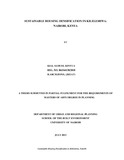| dc.description.abstract | The world is rapidly urbanizing. Many nations all over the world are struggling with the critical challenge of planning urban systems that can accommodate and manage the dynamic processes associated with urban development change. The high level of urbanization has meant that many cities are facing enormous pressure to keep up with the needs of their swelling populations.
In Kenya, the rising urban population has brought along a number of challenges that are
manifested in terms of urban sprawl, congested infrastructure, pollution as well crowding and densification of existing development.
Several studies have been undertaken on the various models of city growth and the merits and demerits that are associated with both compact city model and the horizontal city. The process of urban sprawl outward places enormous pressure on government to keep up with the infrastructure needs. There are also associated ecological foot prints, and this has made governments to promote housing and planning policies aimed at achieving urban densification or urban consolidation. This is in an attempt to halt the spread of populations outward into fringe suburbs, by focusing on rejuvenating and revitalizing existing buildings, roads and public spaces
closer to the city centre in such a way to accommodate higher densities. This factor underlies the rapid transformation of Kileleshwa neighbourhood in Nairobi from low density high income zone to high density middle income zone within the last few years.
At the same time, the high property values closer to the city centre has put intense pressure on government and local authorities to enhance the density standards so that developers can be able to recoup their investments by increasing their output in terms of housing units per unit area of land. Two recent studies have been done in Nairobi's Zone 3, 4 and 5, in 2006 and 2011.
Subsequent to these studies, areas such as Kileleshwa which falls under zone 4 have experienced increasing densities that in some instances are not even in accordance with policy. The resultant developments have strained infrastructural services which have not been expanded to support the growth. The negative impacts associated with the current densification programmes in our urban areas are a cause of concern that call for further study to establish the extent to which such programs do promote sustainable development as provided in our constitution as one of the national values and principles of governance.
Sustainable Housing Densification in Kileleshwa, Nairobi This study was undertaken to determine the extent and nature of housing densification in Kileleshwa and examine the physical and ecological impacts of the densification process.
Further, the study went to investigate the role of green designs and strategies in promoting sustainable development and the extent to which integrating these strategies within the development control framework can guide our cities towards sustainable housing densification.
This was with the aim of developing an alternative intervening policy which can be advanced to guide sustainable densification process in Kileleshwa.
The study hypothesized that the current housing densification in Kileleshwa is unsustainable and requires alternative low impact strategies. The study objectives were thus: to determine the extent and nature of the housing densification in Kileleshwa; to examine the physical and ecological impacts of the densification process; to investigate the extent to which green designs and strategies can be used to mitigate negative impacts of densification process; and finally to develop an alternative intervening policy which can be advanced to guide sustainable densification process in Kileleshwa.
Sources of primary data included personal observation, land use survey, household surveys, key informant interviews, photography and mapping. Secondary data sources included journals, research materials, text books, government reports as well as internet sources. The data from the questionnaires was analyzed using statistical data analysis software, SPSS and consequently conclusions and recommendations were derived based on the study findings
The study found out that there is both vertical and horizontal housing density expansion in Kileleshwa. The densification process has significant physical and ecological impacts on the environment which include; water shortage, power shortage, traffic congestion, pollution, flooding and encroachment on riparian. Others include land use conflict, loss of urban green and insufficient community facilities. The study further found out that the City Council and NEMA as the main regulatory bodies lack sufficient legal, financial and human capacity to enforce green strategies suitable for sustainable densification programmes. Sustainable Housing Densification in Kileleshwa, Nairobi
The study recommends that the Nairobi County Government should integrate green design strategies as mandatory requirements within the development control framework for all upcoming developments in the study area. It further recommends that development control in Kileleshwa should be streamlined and enforcement of planning regulations strengthened. Lastly, the study recommends that existing infrastructure in the area should be upgraded to accommodate the increasing population capacity. | en |

